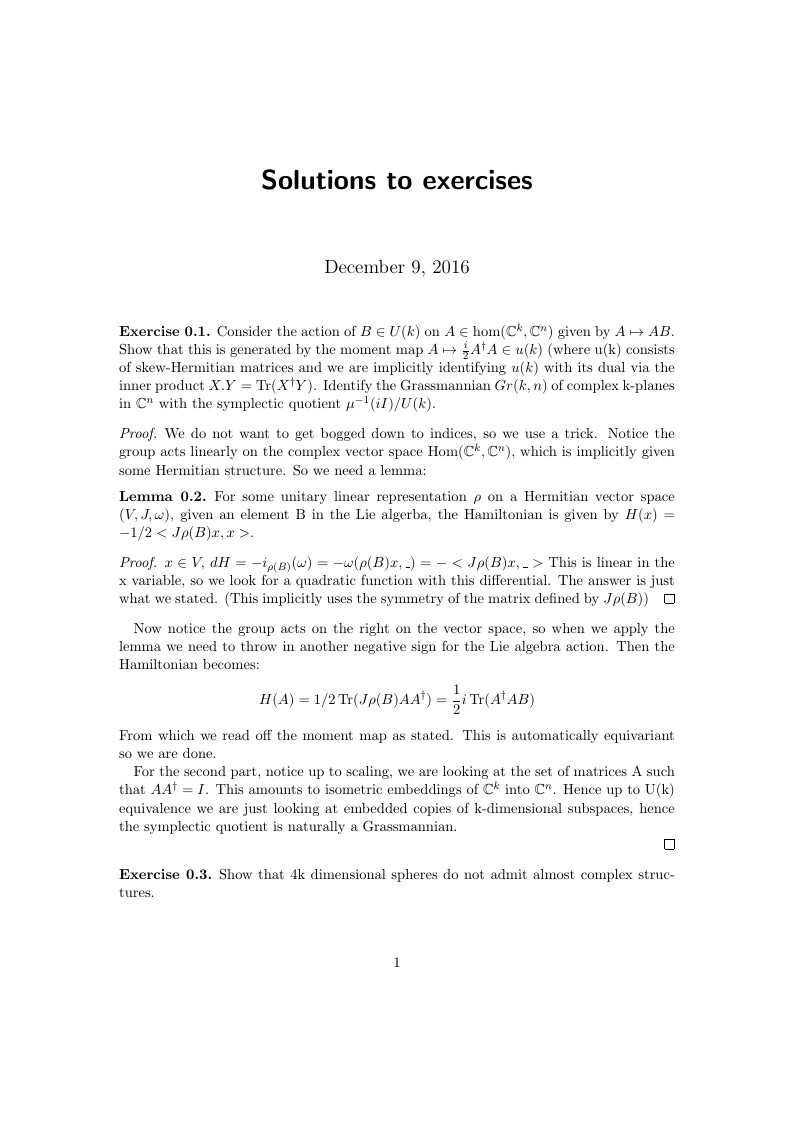
Solutions to exercises
Autor:
liyang
Letzte Aktualisierung:
vor 9 Jahren
Lizenz:
Creative Commons CC BY 4.0
Abstrakt:
Geometry topics exercises

\begin
Discover why over 20 million people worldwide trust Overleaf with their work.
Geometry topics exercises

\begin
Discover why over 20 million people worldwide trust Overleaf with their work.
\documentclass[a4paper]{scrartcl}
\usepackage[english]{babel}
\usepackage[dvips]{epsfig}
\usepackage{amsmath}
\usepackage{amssymb}
\usepackage{amsfonts}
\usepackage{amsthm}
\usepackage{amsbsy}
\usepackage{amsgen}
\usepackage{amscd}
\usepackage{amsopn}
\usepackage{amstext}
\usepackage{amsxtra}
\usepackage{mathrsfs}
\usepackage{enumitem}
\usepackage{graphicx}
\usepackage{verbatim}
\usepackage{epstopdf}
\usepackage{float}
\usepackage[all,cmtip]{xy}
\usepackage{accents}
\usepackage{sseq}
\usepackage{url}
\usepackage{hyperref}
\usepackage{makeidx}
\newtheorem{thm}{Theorem}[section]
\newtheorem{cor}[thm]{Corollary}
\newtheorem{lem}[thm]{Lemma}
\theoremstyle{remark}
\newtheorem{rem}[thm]{Remark}
\newtheorem{obs}[thm]{Observation}
\theoremstyle{definition}
\newtheorem{df}[thm]{Definition}
\newtheorem{exmp}[thm]{Example}
\newtheorem{exc}[thm]{Exercise}
\newtheorem{prop}[thm]{Proposition}
\newtheorem{digr}[thm]{Digression}
\newtheorem{lemma}[thm]{Lemma}
\newtheorem{sol}[thm]{Solution}
%\selectlanguage{english}
\DeclareMathOperator{\Tr}{Tr}
\newcommand{\N}{\mathbb{N}}
\newcommand{\Q}{\mathbb{Q}}
\newcommand{\R}{\mathbb{R}}
\newcommand{\T}{\mathbb{T}}
\renewcommand{\P}{\mathbb{P}}
\newcommand{\C}{\mathbb{C}}
\renewcommand{\H}{\mathbb{H}}
\newcommand{\Z}{\mathbb{Z}}
\newcommand{\F}{\mathbb{F}}
\newcommand{\tr}{\mathrm{tr}}
%math titles bold
\makeatletter
\g@addto@macro\bfseries{\boldmath}
\makeatother
\title{Solutions to exercises}
%\author{Yang Li}
%\date{\today}
\begin{document}
\maketitle
\begin{exc}
Consider the action of $B \in U(k)$ on $A \in \hom(\C^k,\C^n)$ given by $A \mapsto AB$. Show that this is
generated by the moment map $A \mapsto \frac{i}{2}
A^\dagger A \in u(k)$ (where u(k) consists of skew-Hermitian
matrices and we are implicitly identifying $u(k)$ with its dual via the inner product $X.Y =\Tr( X^\dagger Y ) $.
Identify the Grassmannian $ Gr(k, n)$ of complex k-planes in $\C^n $ with the symplectic quotient
$\mu^{-1}(iI)/U(k) $.
\begin{proof}
We do not want to get bogged down to indices, so we use a trick.
Notice the group acts linearly on the complex vector space $\text{Hom}(\C^k, \C^n)$, which is implicitly given some Hermitian structure. So we need a lemma:
\begin{lemma}
For some unitary linear representation $\rho$ on a Hermitian vector space $(V, J,\omega) $, given an element B in the Lie algerba, the Hamiltonian is given by $ H(x)=-1/2<J \rho(B)x,x>$.
\begin{proof}
$x \in V,$
$dH=-i_{\rho(B)}(\omega)=-\omega(\rho(B) x, \_ )=-<J\rho(B) x, \_> $
This is linear in the x variable, so we look for a quadratic function with this differential. The answer is just what we stated. (This implicitly uses the symmetry of the matrix defined by $J\rho(B)$)
\end{proof}
\end{lemma}
Now notice the group acts on the right on the vector space, so when we apply the lemma we need to throw in another negative sign for the Lie algebra action. Then the Hamiltonian becomes:
$$H(A)=1/2\Tr(J\rho (B)A A^\dagger)=\frac{1}{2}i \Tr(A^\dagger AB ) $$
From which we read off the moment map as stated. This is automatically equivariant so we are done.
For the second part, notice up to scaling, we are looking at the set of matrices A such that $A A^\dagger=I$.
This amounts to isometric embeddings of $\C^k$ into $\C^n$. Hence up to U(k) equivalence we are just looking at embedded copies of k-dimensional subspaces, hence the symplectic quotient is naturally a Grassmannian.
\end{proof}
\end{exc}
\begin{exc}
Show that 4k dimensional spheres do not admit almost complex structures.
\begin{proof}
The basic topological feature of the tangent bundle is that it is stably trivial. This is because the sphere sits inside the Euclidean space, and the normal bundle is a 1D trivial bundle. Thus $\R^{4k+1}=\R\bigoplus TS^{4k}$.
This means the Chern classes of the complexified tangent bundle are trivial.
Now suppose we have an almost complex structure, then the complexified bundle splits into (1,0) and (0,1) parts which are complex vector bundles. Most of the Chern classes vanish for purely degree reasons. But the top Chern class of the (1,0) bundle is the Euler characteristic times the fundamental class, by Gauss Bonnet. Now since the top Chern class is $c_{2k}$ we observe the conjugate bundle has the same Chern class. Then an application of Whitney sum formula gives a contradiction of the value of the top Chern class of the complexified tangent bundle.
\end{proof}
\end{exc}
\end{document}